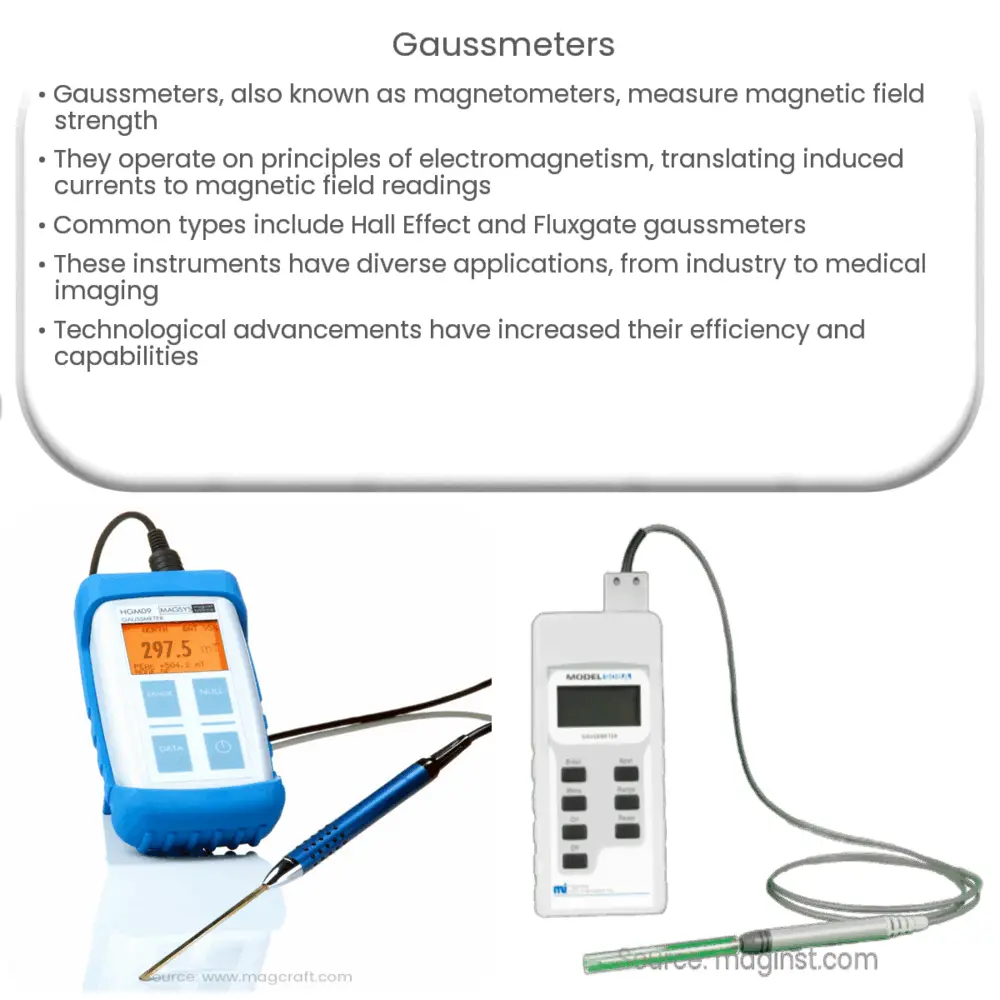Explore the fascinating world of Gaussmeters, their working principle, applications, key features, limitations, and latest advancements.

Gaussmeters: Unveiling the Invisible
A Gaussmeter, otherwise known as a magnetometer, is an instrumental device used to measure the strength and direction of a magnetic field. The Gauss unit is named after the renowned German mathematician and physicist, Johann Carl Friedrich Gauss, who made significant contributions to the understanding of magnetism.
Types of Gaussmeters
- Hall Effect Gaussmeters: These are the most commonly used gaussmeters. They function by applying a voltage to a thin conducting plate (Hall element) and then placing it in a magnetic field. The magnetic field will cause a deflection of charge carriers in the plate, which creates a Hall voltage that can be measured and is directly proportional to the strength of the magnetic field.
- Fluxgate Gaussmeters: These are more complex and less common than Hall effect meters. Fluxgate gaussmeters work by inducing a magnetic field in a small piece of magnetically susceptible material, like iron, and then measuring the magnetic field it creates. The stronger the ambient magnetic field, the stronger the induced field, making it possible to measure the magnetic field’s strength.
Key Applications of Gaussmeters
Gaussmeters have wide-ranging applications. In industry, they’re used in manufacturing for quality control purposes, particularly in industries that require precise magnetic properties, such as the manufacturing of magnets, motors, and transformers. Gaussmeters are also essential tools in the field of medicine, especially in magnetic resonance imaging (MRI).
How Do Gaussmeters Work?
At the core, a Gaussmeter operates on principles of electromagnetism. When a conductor is exposed to a changing magnetic field, it causes the movement of electric charges within the conductor, creating an electric current. This process is known as electromagnetic induction. The gaussmeter measures this induced current or voltage, which is then calibrated to the strength of the magnetic field.
The Gaussmeter consists of a probe containing a magnetic sensor, connected to a reader unit. The probe is placed in the magnetic field to be measured, and the reading is shown on the display of the reader unit. Depending on the specific Gaussmeter, the measurements can be made in Gauss, Tesla, or Amps/Meter2.
Important Features of Gaussmeters
When choosing a Gaussmeter, certain key features must be considered. The range of magnetic field the device can measure is critical, as well as the unit of measurement. Some devices can measure both DC and AC magnetic fields, which can be useful for more advanced applications. The precision and accuracy of the device are also crucial, especially for scientific and industrial applications.
Limitations of Gaussmeters
Despite their utility, Gaussmeters do have some limitations. They are sensitive to temperature variations, which can affect their accuracy. Additionally, the presence of other electric or magnetic fields can interfere with measurements. To address these challenges, it is crucial to use Gaussmeters in controlled environments or to apply necessary adjustments or calibrations.
Latest Advances in Gaussmeter Technology
Technology advancements are continuously enhancing the efficiency and capabilities of Gaussmeters. The latest models feature digital technology, which allows for more accurate and faster measurements. Additionally, many new Gaussmeters are equipped with data logging capabilities, enabling users to store measurements for future reference or analysis. Some models even feature Bluetooth connectivity for easy data transfer.
Conclusion
In conclusion, Gaussmeters play a critical role in a wide range of applications, from industrial manufacturing to medical diagnostics. Understanding how these devices work is crucial for scientists, engineers, and technicians working in fields that require precise magnetic field measurements. Despite certain limitations, ongoing advancements in Gaussmeter technology continue to expand their capabilities, making them an increasingly valuable tool in various fields.
As the world becomes more technologically advanced, the demand for accurate and reliable magnetic field measurements is set to increase, further cementing the Gaussmeter’s place as an essential scientific instrument. Indeed, through the measurement of invisible forces, Gaussmeters help make the unseen world tangible and navigable.

